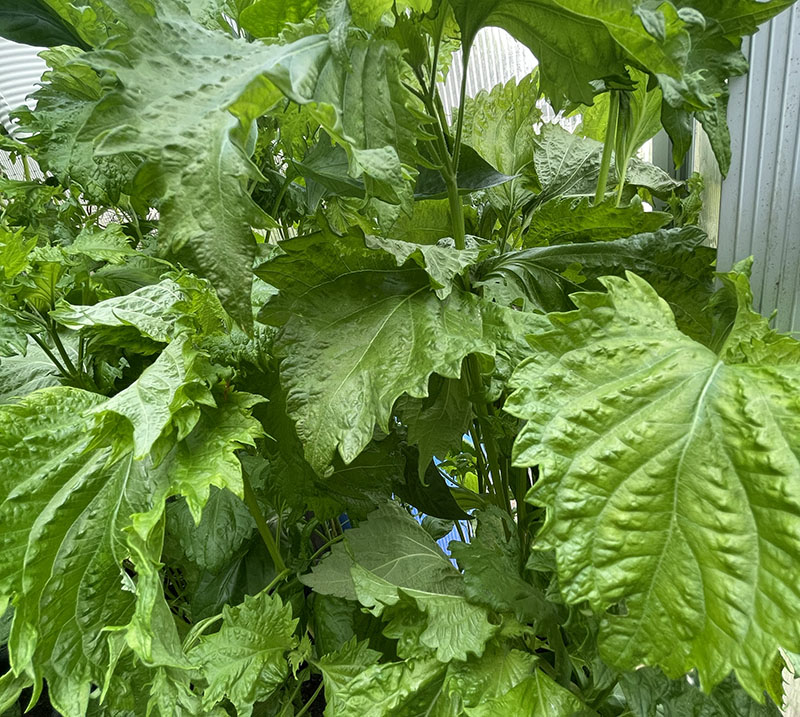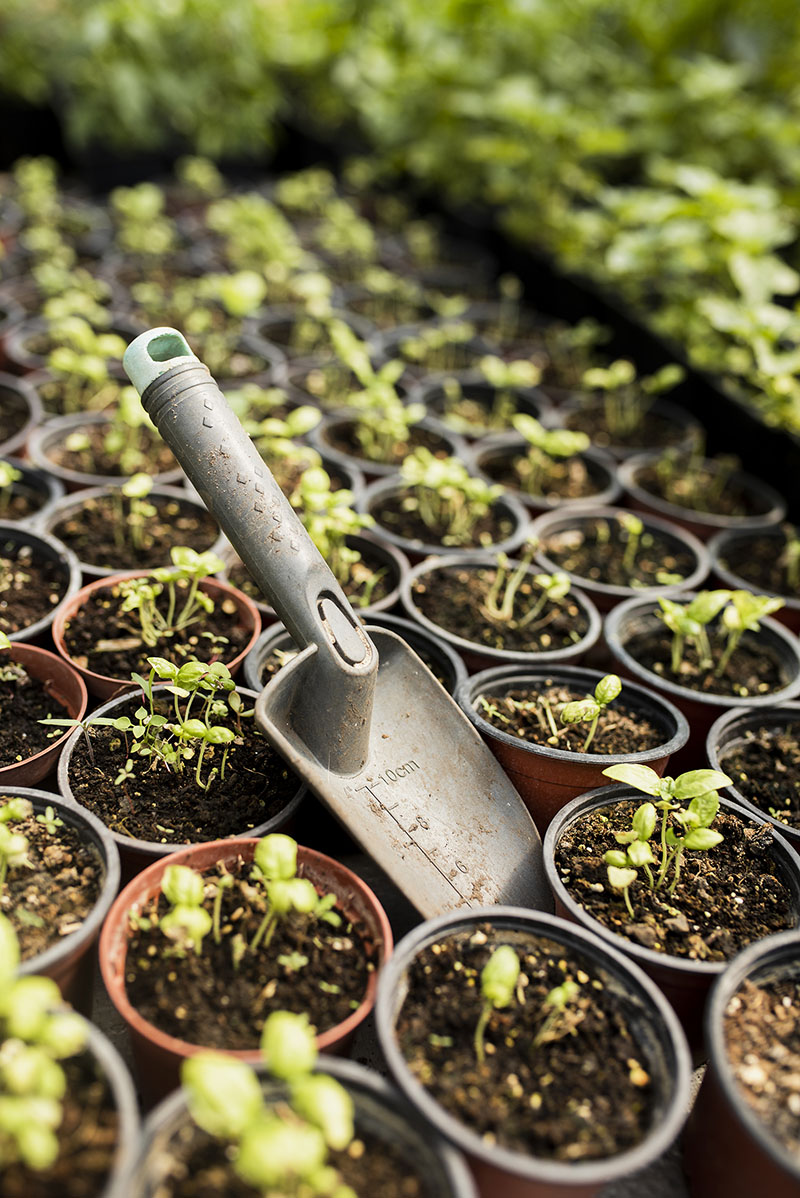
Exploring Ingredients: Shiso

Shiso leaves have recently become a valued addition to our kitchen garden. This herb had caught our attention, particularly as we were exploring more Asian and Far Eastern cuisine. We noticed it featuring prominently in Japanese, Korean, and Vietnamese recipes. Unfortunately, in our local area, it’s not readily available for purchase, which got us thinking, why not try growing it ourselves?
After some online research, we were fortunate to find shiso seeds available for sale at a reasonable price. We decided to give it a go, and to our pleasant surprise, cultivating it was a piece of cake. With a little warmth from a heated propagator, the seeds germinated rapidly, and in just a week, we saw our shiso seedlings dutifully sprouting up.
It’s fascinating to see how quickly this herb takes to grow, and we now have a fresh supply of shiso right at our fingertips. We’re now eager to explore new recipes that feature this versatile and flavourful herb. Growing it is certainly a rewarding experience, and we’re adding its aromatic leaves to many Asian-inspired dishes.
Known by its botanical name Perilla frutescens, the leafy herb is commonly grown in the UK as an ornamental foliage plant. Many gardeners recognise it as perilla. One of its popular aliases is the beefsteak plant, likely due to its striking red-purplish colour variation. Its vibrant and lush leaves make it an excellent choice for summer bedding plants, adding a burst of visual appeal to gardens.
What’s even more wonderful is that it not only looks good but tastes great too. With its dual purpose as both an ornamental and a culinary plant, it becomes a valuable addition to any garden. Shiso comes in various colour variations, including purple, red, and green. In our garden, we’re cultivating the green ruffled-leaved type.
What do shiso leaves taste like?
Shiso is sometimes called Japanese basil and interestingly, it belongs to the mint family, just like basil. So, it’s no surprise that they share some flavour similarities, especially when it comes to their spicy nature.
When you taste its leaves, you’ll notice its bright and refreshing flavour, reminiscent of mint or basil. It also carries hints of cinnamon, cloves, anise, and coriander, adding further aromatic notes to its taste profile. Like many herbs, shiso has a mildly astringent tang with a subtle bitter finish.
One of the remarkable aspects of shiso is its robust flavour, which stands up well to a variety of other ingredients. So, it’s an excellent choice to enhance and complement different flavours in your dishes.
We’ve been having a great time experimenting with it in our kitchen. Not only have we discovered that it adds a fantastic touch to stir-fries, making them even more flavourful but chopping and incorporating shiso into meatballs has been a taste revelation, making them a little more special.
Another way we’ve been using shiso is by pureeing it with oil to create a tasty condiment. While these may not be the traditional uses for shiso leaves, they’ve proven to be absolutely delicious and worth a try.
How to use shiso leaves in cooking

In Japanese cuisine, shiso leaves come in two main varieties: green and red. The green shiso leaves are widely popular and find use throughout the year in various dishes. They impart a delightful flavour to numerous recipes and add a fresh, aromatic touch.
On the other hand, red shiso leaves serve a different purpose. While they are less common in everyday cooking, they play a crucial role in enhancing the visual appeal of certain foods. Red shiso leaves are often employed as a natural food colouring agent, particularly in items like umeboshi (pickled plums) and pickled ginger (beni shoga).
During the summer season, the Japanese relish a revitalising and invigorating drink known as aka shiso juice or red perilla juice. This delicious beverage is crafted using the vibrant red shiso leaves and holds a special place in their culinary traditions. Not only does it offer a thirst-quenching relief on hot, sweltering days, but it also has reputed benefits for the body.
Aka shiso juice is cherished for its ability to stimulate the appetite, making it a perfect companion to enjoy during the scorching summer heat. Moreover, it is believed to aid in the recovery from fatigue and help with digestion, making it even more appealing as a go-to refreshment.
In the world of traditional Japanese food presentation, shiso plays a crucial role as a clever and practical element. When arranging a tray or platter of various delicacies, shiso leaves are skilfully used to separate the individual items, ensuring their distinct flavours remain intact and don’t blend together.
Shiso leaves boast antibacterial properties that can be attributed to special compounds known as phytoncides. These natural compounds are believed to play a significant role in preventing the spoilage of food when wrapped in the leaves. In fact, the Japanese have been utilising shiso leaves for centuries to slow down the spoilage process of raw fish and seafood.
Shiso leaves offer a range of culinary possibilities, especially during the summer. You can use them to add a refreshing twist to summer rolls or inari sushi. For a crispy delight, try deep-frying whole shiso leaves as part of your vegetable tempura platter.
These leaves pair wonderfully with fatty fish like salmon, tuna, or salmon roe (ikura). Enjoy them by wrapping a piece of sashimi in a shiso leaf and dipping it in soy sauce.
Another idea is to incorporate shiso leaves into a sashimi bowl to elevate its flavours and add a touch of freshness.
Where can I buy shiso leaves?
Unless you live near an Asian supermarket, fresh shiso leaves are quite hard to come by. They are available to buy online from some very specialist suppliers but are quite expensive for a a relatively small amount. However, the seeds are easy to find and as the plant is easy to grow, this is by far the most cost effective option.
See our list at the end of this article for some reliable UK suppliers.
How to grow shiso leaves

Growing shiso leaves can be a rewarding experience, and it’s best to start with seeds and nurture them into seedlings. For faster germination, soak the seeds overnight before sowing.
We like to start ours indoors in seed modules placed inside a heated propagator. These can be transplanted outside when the chance of frost has passed or if you are more cautious they can be grown in a large container in a greenhouse.
Sow the seeds 1mm deep. Be mindful not to bury them too deep, as they require light for germination. In regions prone to frost, it’s advisable to wait until the last frost date before sowing. If sowing outside, wait until temperatures reach 20°C or above in spring. In regions prone to frost, it’s advisable to wait until the last frost date before sowing.
Germination can take anywhere from 7 to 21 days, so be patient. Once the seedlings have developed their first or second true leaves, it’s time to transplant them to their permanent location. Space the seedlings about 30cm apart in moist soil with full sun exposure, although they can tolerate partial shade. Shiso plants typically grow to a height of 60cm, and it takes approximately 70 days for mature leaves to form.
Whether you choose to grow shiso in containers or a raised garden bed, both methods yield similar results. Some gardeners recommend pinching out the top shoot of the plant to encourage bushier growth, but in our experience, this hasn’t been necessary.
Taking care of shiso plants is relatively easy once they are established. Ensure the soil stays moist, especially on hot days. You can use liquid fertiliser every fortnight, but we prefer preparing the soil beforehand with compost and organic nutrients instead. Fortunately, shiso attracts very few pests, making maintenance a breeze.
When it’s time to harvest, wait until the leaves have reached maturity, around 70 days after sowing. Towards the end of the growing season and the start of autumn, the plant will produce flowers that eventually turn into seeds. You can harvest and store these seeds for the next planting season.
Seed suppliers for shiso/perilla*
Chiltern Seeds – chilternseeds.co.uk
Jekka’s – jekkas.com
Johnsons – johnsons-seeds.com
Nickys Nursery – nickys-nursery.co.uk
Premier Seeds Direct – www.premierseedsdirect.com
Real Seeds – www.realseeds.co.uk
* The Artisan Food Trail is not affiliated with any of these companies.
Photo (main image): © childsdesign
Sign up to receive our newsletter
For the latest producer info, shows, markets, recipes, competitions and more each month.
Please be assured that we don't sell or pass on your information to third parties.
Keep up to date with:
- New and approved producers and produce
- Offers, discounts, competitions and more
- Seasonal produce and great tasting downloadable recipe ideas
- Shows, events and markets
